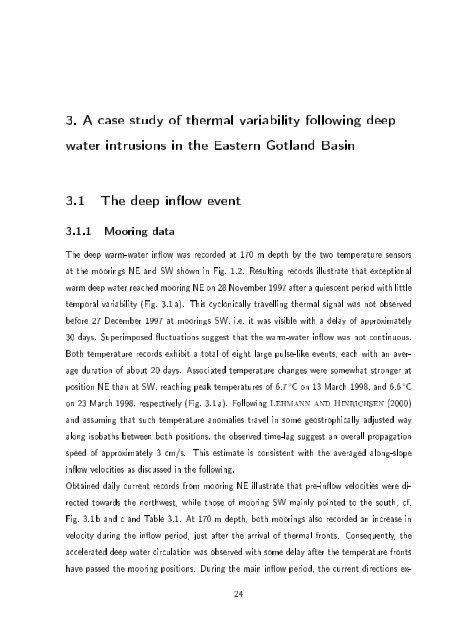Baltic Sea
Baltic Sea
Baltic Sea
You also want an ePaper? Increase the reach of your titles
YUMPU automatically turns print PDFs into web optimized ePapers that Google loves.
3. A case study of thermal variability following deep<br />
water intrusions in the Eastern Gotland Basin<br />
3.1 The deep inow event<br />
3.1.1 Mooring data<br />
The deep warm-water inow was recorded at 170 m depth by the two temperature sensors<br />
at the moorings NE and SW shown in Fig. 1.2. Resulting records illustrate that exceptional<br />
warm deep water reached mooring NE on 28 November 1997 after a quiescent period with little<br />
temporal variability (Fig. 3.1 a). This cyclonically travelling thermal signal was not observed<br />
before 27 December 1997 at moorings SW, i.e. it was visible with a delay of approximately<br />
30 days. Superimposed uctuations suggest that the warm-water inow was not continuous.<br />
Both temperature records exhibit a total of eight large pulse-like events, each with an average<br />
duration of about 20 days. Associated temperature changes were somewhat stronger at<br />
position NE than at SW, reaching peak temperatures of 6.7 ◦ C on 13 March 1998, and 6.6 ◦ C<br />
on 23 March 1998, respectively (Fig. 3.1 a). Following Lehmann and Hinrichsen (2000)<br />
and assuming that such temperature anomalies travel in some geostrophically adjusted way<br />
along isobaths between both positions, the observed time-lag suggest an overall propagation<br />
speed of approximately 3 cm/s. This estimate is consistent with the averaged along-slope<br />
inow velocities as discussed in the following.<br />
Obtained daily current records from mooring NE illustrate that pre-inow velocities were directed<br />
towards the northwest, while those of mooring SW mainly pointed to the south, cf.<br />
Fig. 3.1 b and c and Table 3.1. At 170 m depth, both moorings also recorded an increase in<br />
velocity during the inow period, just after the arrival of thermal fronts. Consequently, the<br />
accelerated deep water circulation was observed with some delay after the temperature fronts<br />
have passed the mooring positions. During the main inow period, the current directions ex-<br />
24



